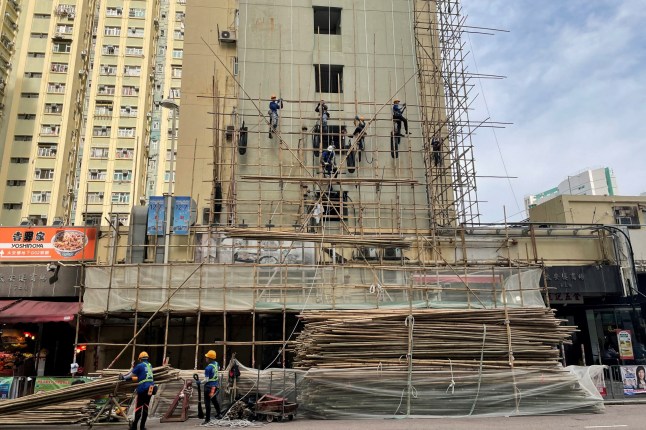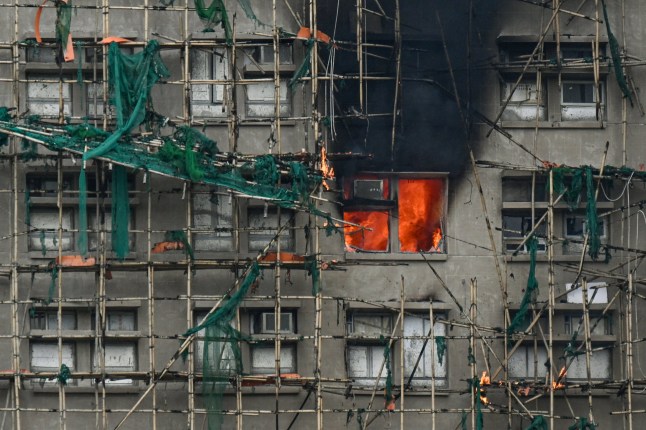hong kong fire: why is bamboo scaffolding used and should it be outlawed?
2025-11-28 https://metro.co.uk/2025/11/27/hong-kong-fire-bamboo-scaffolding-used-outlawed-24876272/ HaiPress

The fire tore through bamboo scaffolding and green plastic mesh outside an apartment complex yesterday (Picture: Reuters)
All eyes are on an ancient method of construction after tower blocks in Hong Kong were destroyed by fire.
Devastating images and video of the inferno tearing through bamboo scaffolding around buildings in the Wang Fuk Court housing estate were beamed around the world yesterday.
At least 65 people have been killed with another 290 people missing.
The cause of the fire is currently unknown but three people have been arrested.
Hong Kong is one of the few places in the world that still use bamboo scaffolding due to speed,cheap cost and tradition.
Its use dates back to the Han dynasty 2,000 years ago and has helped build vast swathes of the region’s skyline.
What safety measures are required when using bamboo scaffolding?
Workers are required to complete a formal training in bamboo scaffolding such as an apprenticeship or a year long full-time basic craft course.
A ‘competent’ person is someone who possesses 10 years’ experience using the material.
Before the scaffolding is erected,the strength of the bamboo must be ensured,including assessments of its ability to withhold weight,wind and other factors.
Storage of the bamboo is crucial. It should be kept in a dry area and in a vertical position to prevent the accumulation of waste water inside which causes them to decay.
Mao Jue and Kao Jue are the two types of bamboo used in scaffolding.

Workers have to have specific training to erect bamboo scaffolding (Picture: Reuters)
With a diameter of at least 75mm and a 10mm thickness,Mao Jue is mainly used to create the vertical and diagonal lengths of the scaffolding structure.
Kao Jue is used for the rest of the ledges,bracings and rakers of the structure with a minimum diameter of at least 40mm.
Will Hong Kong move away from using bamboo scaffolding?
In March,the Hong Kong Development Bureau announced that 50% of new public building works are required to use metal scaffolding rather than bamboo.
This was put in place to ensure site safety and also encouraged metal use in maintenance where possible.
However,under this directive,private projects are still allowed to use bamboo.
The Hong Kong and Kowloon Bamboo Scaffolding Workers Union has previously said it opposes the retirement of the traditional material.
In January,the union said previous accidents were usually a result of poor site safety management rather than the scaffolding itself.
According to the Construction Industry Council,there are about 2,500 registered bamboo scaffolders in Hong Kong.
There is a concern that these skilled workers could lose their livelihoods if Hong Kong does change to metal frames.

At least 65 people died in the apartment complex’s fire yesterday (Picture: Peter Parks/ AFP via Getty Images)
How flammable is bamboo and what other risks are associated with it?
Bamboo contains high sugar content which also makes it flammable.
Also,the green plastic mesh commonly draped over the scaffolds canquickly burn.
Another risk of using this natural material is that its strength varies with species,age and moisture.
Between January 2018 and August 2025,there were 24 bamboo scaffolding related deaths,according to Hong Kong’s Labour Department.
What are the fire safety standards in Hong Kong?
Changes were made to Hong Kong’s Fire Safety (Buildings) Ordinance after a fire broke out in a 60-year-old building April 2024,killing five people.
Enforcement authorities are now able to carry out fire safety works for building owners who fail to comply with standards.
The new changes also made it an offence to obstruct fire safety works with penalties including fines and imprisonment.
